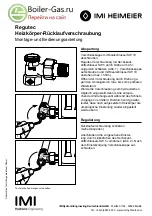
GWA/GWI/GWS
Gas-Fired Water Boilers –
User’s Information Manual
10
Part Number 550-110-726/0703
❏
Check monthly
Boiler piping
1. Visually inspect for leaks around piping, circulators, relief valve
and other fittings. Immediately call a qualified service
technician to repair any leaks.
Have leaks fixed at once by a qualified service tech-
nician. Continual fresh makeup water will reduce
boiler life. Minerals can build up in sections, reduc-
ing heat transfer, overheating cast iron, and caus-
ing section failure.
Do not use petroleum-based cleaning or sealing
compounds in boiler system. Severe damage to
boiler and system components can occur, resulting
in possible severe personal injury, death or sub-
stantial property damage.
Venting system
1. Visually inspect all parts or the flue gas venting system for
any signs of blockage, leakage or joints or deterioration of
the piping.
2.
GWA boilers
— Check vent system operation:
a. With boiler firing, hold a candle or match below lower edge
of draft hood “skirt.” If flame does not blow out, but burns
undisturbed, the vent system is working properly. If flame
blows out or flickers severely, the vent system must be
checked for obstructions or other causes of improper
venting.
b. Verify the vent damper opens before burners ignite.
3. Notify your qualified service technician at once if you find any
problem.
Failure to inspect the vent system as noted above
and have it repaired by a qualified service techni-
cian can result in vent system failure, causing se-
vere personal injury or death.
Check condensate drain system (GWI or GWS)
1. Inspect condensate drain fittings and tubing. Verify that
condensate can flow freely to drain.
Boiler relief valve
1. Inspect the boiler relief valve and the
relief valve discharge pipe for signs of
weeping or leakage.
2. If the relief valve often weeps, the
expansion tank may not be working
properly.
•
Immediately contact your qualified
service technician to inspect the
boiler and system.
Automatic air vents (if used)
1. Remove the cap from any automatic
air vent in the system and check
operation by depressing valve
B
slightly with the tip of a screwdriver.
2. If the air vent valve appears to be
working freely and not leaking, replace
cap
A
, twisting all the way on. Loosen
cap
A
one turn to allow vent to operate.
3. Have vent replaced if it does not
operate correctly.
Pilot burner flame
Proper pilot flame (see below):
1. Blue flame.
2. Inner cone engulfing thermocouple (standing pilot) or pilot
flame sensor (spark-ignited pilot).
3. Thermocouple or pilot flame sensor glowing cherry red.
Improper pilot flame:
1. Overfired — Large flame lifting or blowing past pilot flame
sensor.
2. Underfired — Small flame. Inner cone not engulfing pilot flame
sensor.
3. Lack of primary air — Yellow flame tip.
4. Incorrectly heated pilot flame sensor.
❏
Check monthly






























